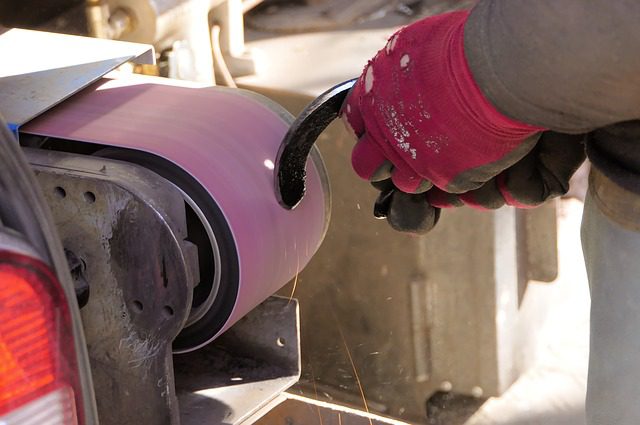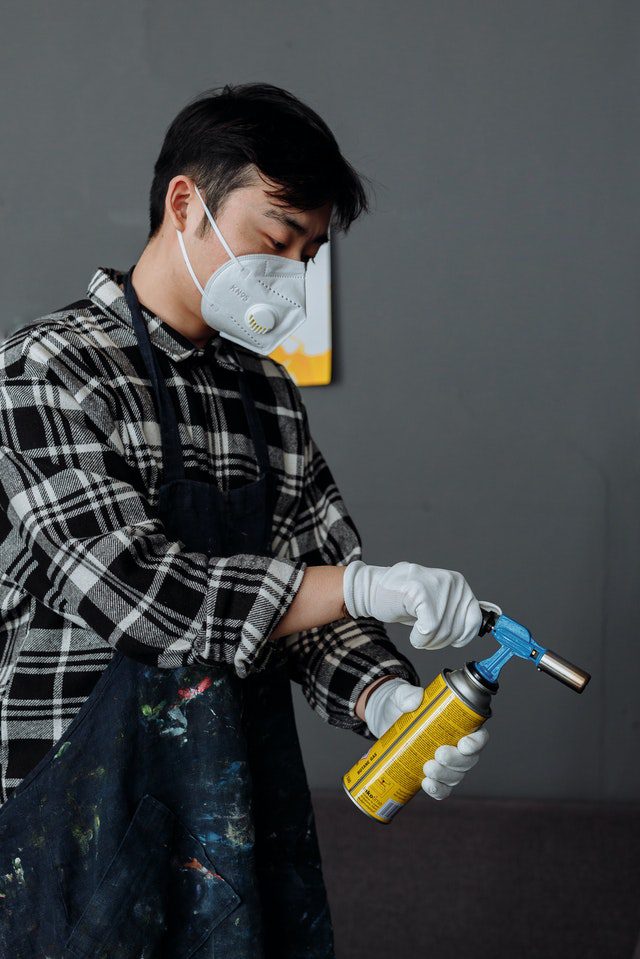
Updated for 2025: This guide has been refreshed with updated methods, expert advice, and practical tips to help you remove paint from metal surfaces efficiently and safely.
Are you prepping your metal surface for a repaint? Removing paint from metal can be a straightforward process with the right tools, techniques, and a bit of elbow grease. Whether you’re working on a delicate doorknob, a large piece of machinery, or outdoor structures like fence posts, this guide will help you tackle the task efficiently.
The good news is that there are several tried-and-tested methods to strip paint from metal surfaces, ensuring they’re ready for a fresh coat. Before you get started, don’t forget to check out our tips on How To Paint A Door for more project inspiration.
Before diving into the step-by-step methods for paint removal, let’s first talk about the necessary precautions to keep your work safe and effective:
Safety Precautions before Stripping Paint Off Metal
Wear your safety gear: These will include gloves, a mask and goggles. Opt for an N95 mask to avoid breathing in the particles if you plan to remove rust.
Work in a well-ventilated area: Paint fumes are toxic and harmful if inhaled. Furthermore, chemical paint strippers are flammable and can cause a fire if not used correctly.
Check for lead: Many older paints contain lead, so if you’re working on something pre-1960, it’s a good idea to test for lead paint via a lead testing kit. Paint lead is extremely hazardous can cause a variety of health problems.
Now that we’ve got the safety measures out of the way, you’ll first need to prep your surface by removing any loosened paint.
Here are some painting mistakes you wouldn’t want to commit.
Prep your Metal Surface by Removing Loosened Paint
For older metal pieces, there may be some paint chipping or peeling off. Before removing your metal’s paint, start by removing any loose paint with a paint scraper or wire brush. Your choice of wire brush will depend on the metal; for brass or copper, use a brass brush and for stainless steel, use a stainless steel brush.
This is great for outdoor structures like fence posts which are exposed to the elements. Over time paint on fence posts can chip and wear off leaving the metal to rust and corrode. By removing loose paint and prepping the surface you can get a smooth and durable finish that protects the metal and looks great. Well maintained fence posts are critical for structural integrity and will extend the life of your fence.
Once loose paint is gone, proceed with any of the following methods for metal paint removal:
How to Remove Paint from Metal using a Chemical Paint Stripper
If you’re dealing with a large piece of machinery or metal surfaces with a lot of paint buildup, using a chemical stripper is your best bet. Chemical strippers can be purchased at most hardware stores and come in both liquid and gel forms. Removal instructions, however, will vary depending on your chosen product.
Follow these steps for using a liquid chemical stripper to remove paint from metal:
1. Apply a thick layer of chemical stripper to your brush and scrub your painted surface.
2. Wait for the paint to start bubbling or rippling. This means the stripper is working, and the paint is breaking down.
3. Use a paint scraper or wire brush to strip the paint off. If paint remains, simply repeat the process.
Remove Paint from Metal with Heat

High temperatures will cause metal paint to soften, essentially melting it off the surface. For smaller areas, a heat gun is ideal as it offers more precision. You can tackle larger areas with a blow torch, but be careful not to apply too much heat, or you’ll damage the metal. Also, you should be cautious if using a blow torch in enclosures equipped with metal/electrical components like an Amerec sauna heater since it can damage their surfaces.
Before using a heat gun, be sure to wear heat protective gloves.
1. Turn your heat gun on its lowest setting.
2. Apply the gun to the paint and gradually increase the heat. Going too hot initially will warp the metal.
3. Hold your heat gun in place until the paint begins to bubble or melt.
4. Once the paint has melted, use a scraper or wire brush to remove all the paint. For stubborn paint, use sandpaper and finely sand your metal surface.
This metal paint removal method can be strenuous for one person to do it alone. We recommend two people working together – one to hold the heat source and one to scrape off the paint.
How to Strip Paint Off Metal Using a Sanding Disc
For heavy-duty paint removal, you can use a sanding disc on an angle grinder. This is a more aggressive approach and can damage the metal if not done correctly. However, it’s highly effective in removing paint and requires minimal effort, making it a popular choice for stripping corrosion and paint off metal.
Follow these steps when using a sanding disc on an angle grinder to strip paint from metal:
1. Attach a sanding disc to your angle grinder. An 80-grit disc is ideal for paint removal.
2. Be sure to keep the grinder moving in a consistent motion and do not apply too much pressure, or you’ll damage the metal.
3. Once over half of your paint is removed, switch to a 180-grit sanding disc to finish the job. This finer grit will give a smoother finish while keeping the material intact.
How to Remove Paint from Metal without Chemicals
Vinegar works as a natural metal paint remover if you’d rather not use chemicals. Baking soda also has abrasive qualities that can remove paint. For this method, we’re going to use vinegar as our choice for removing paint.
1. Heat an old pan and fill it with water and vinegar. Add 60ml of vinegar for every liter of water that’s poured.
2. Bring the vinegar to a boil and add your metal pieces.
3. Leave the metal in the pan and wait for the paint to start bubbling and peeling off.
4. Once the paint has broken down, use a wire brush to remove the existing paint.
Pro Tips for Effective Paint Removal
To achieve the best results when removing paint from metal, keep these expert tips in mind:
Test first: Always test a small, inconspicuous area of the metal before applying any removal method to ensure it won’t damage the surface.
Be gentle: Use light and consistent pressure when scraping or sanding to preserve the integrity of the metal. Over-sanding or scraping too aggressively can leave scratches or dents.
Take your time: Avoid rushing the process. Allow the paint removal product or heat gun to work effectively, reducing the risk of damaging the metal or creating uneven surfaces.
Manual Sanding to Remove Paint from Metal
If you lack equipment and are looking for a budget-friendly option, sandpaper is your best bet. This process is slow and tedious, and requires a lot of elbow grease, but it’s a safe and effective way to remove paint from metal. Hand sanding is a good option for smaller objects that just need touching up.
1. Begin with coarse-grit sandpaper, such as 60-grit.
2. Sand the paint in the same direction as the metal’s grain to help preserve the metal’s surface.
3. Switch to finer-grit sandpaper, such as 180-grit, when half of the paint is removed.
What to do After Removing Paint from Metal
Now that your paint is off the metal’s surface, it’s important to clean and protect the metal from corrosion. Apply white spirits onto a clean cloth and wipe down the metal – this will remove any grease or remaining paint. Once dry, your surface is ready to be painted or rust-protected.
Removing paint from metal can be time-consuming and tricky, but you can do it with the right tools and techniques. Be sure to use caution when using heat or chemicals to avoid damaging the metal. With a bit of patience, you’ll have a clean and shining metal surface in no time.
Planning on painting aluminium material? Check this out. Meanwhile, if you are planning on prepping your walls for painting next, here are some tips on How To Prepare Your Walls For Painting.
NewlinePainting – Melbourne Residential Painters
If you’re ready to start your painting project but not sure where to start, we’re here to help! Our team of professional Melbourne house painters provide a range of painting services for our residential clients. Our services span across all of Melbourne, including Frankston, Blackburn, Hawthorn, Northcote, Prahran, and Ringwood.
From preparing your surface to choosing the right paint, we’ll take care of everything for you. After all, we can handle all types of exterior and interior house painting services such as kitchen painting, driveway painting, living room painting, and more.
Give us a call today at 1300 044 206 to get started or book online for a free quote!




